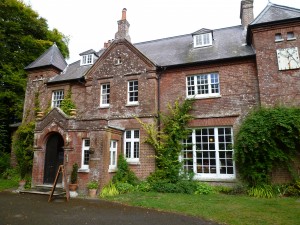 Conrad was a sea captain, Chekhov was a doctor, but Thomas Hardy is the only famous writer I know who was an architect. Born in modest circumstances, he was apprenticed to an architect as a lad, and worked in London for five year before returning to his native Dorset to devote his time to writing. Max Gate is the name of the house that he designed for himself in Dorchester. He was 45 when he built the house, and he lived there for more than 40 years, until his death–he died in the upstairs bedroom–in 1928. Here he wrote The Mayor of Casterbridge, Tess of the d’Urbervilles, and Jude the Obscure. Hardy designed the house himself. I’m not usually a fan of Victorian architecture, but Hardy’s house has an appealing austerity. It is also unusually bright inside, for he made the windows exceptionally large, in part to see the extraordinary garden that surrounds the house. The building began as a rather small center hall, two-over-two plan, but over time, as Hardy’s writing became popular, he was able to add the entry porch and several rooms at the rear, including a study. The sundial was designed by Hardy, although added after his death. The inscription reads QUID DE NOCTE? (What of the night?), from a Latin verse.
Conrad was a sea captain, Chekhov was a doctor, but Thomas Hardy is the only famous writer I know who was an architect. Born in modest circumstances, he was apprenticed to an architect as a lad, and worked in London for five year before returning to his native Dorset to devote his time to writing. Max Gate is the name of the house that he designed for himself in Dorchester. He was 45 when he built the house, and he lived there for more than 40 years, until his death–he died in the upstairs bedroom–in 1928. Here he wrote The Mayor of Casterbridge, Tess of the d’Urbervilles, and Jude the Obscure. Hardy designed the house himself. I’m not usually a fan of Victorian architecture, but Hardy’s house has an appealing austerity. It is also unusually bright inside, for he made the windows exceptionally large, in part to see the extraordinary garden that surrounds the house. The building began as a rather small center hall, two-over-two plan, but over time, as Hardy’s writing became popular, he was able to add the entry porch and several rooms at the rear, including a study. The sundial was designed by Hardy, although added after his death. The inscription reads QUID DE NOCTE? (What of the night?), from a Latin verse.
On Culture and Architecture

Not to forget Sir John Vanbrugh.
When he wasn’t designing Castle Howard he was one of the more celebrated Restoration dramatists.
Absolutely right. I was sure I had forgotten someone.
No doubt there are others out there.
Meanwhile, the sundial inscription is a nice touch. Its contrarian feel rather put me in mind of the one Alberti picked for the self-portrait medallion he designed for himself: “Quid tum,” generally rendered as “so what.” Someone has tracked it down to Virgil, I believe.